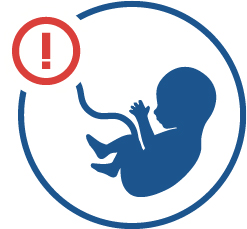Pertussis and Influenza Infections Can Cause Substantial Morbidity and Mortality in Young Infants, and Influenza Infection Can Cause Complications During Pregnancy
Pertussis Infection
The worldwide estimated pertussis burden in infants (<12 months of age) is:1

5.1 million
pertussis cases*1

85,900
pertussis-related deaths*1
*Modelled on 2014 data.
~50% of infected infants will require hospital treatment.2 Infants aged <6 months have the highest risk of severe infection requiring hospitalisation. In one study, 85% of infants admitted to the paediatric intensive care unit were <4 months of age.3 In the most severe cases, pertussis infections can lead to pneumonia, permanent brain damage, and even death.4
Influenza Infection
In the United States, influenza-associated mortality in infants is the highest in infants <6 months of age, among children from 0–16 years.5

270,000
estimated infant influenza hospitalisations worldwide each year6

Infants (<6 months of age)
are extremely vulnerable to influenza-associated respiratory diseases6
Average annual incidence of influenza-associated deaths per 100,000 children in the United States, 2010–2016.5

Influenza infection leads to serious outcomes in pregnant women and their babies including hospitalisations, hypertension (+21%†), foetal abnormality (+53%†), lower birth weight (+11%†), and deaths.7



†Adjusted odds ratios of women with a diagnosis of seasonal influenza virus infection versus those without influenza infection.
During the influenza season, there is also an increased risk of delivery complications in pregnant women.8
Since 2012, WHO recommends that pregnant women be given the highest priority for vaccination at any stage of pregnancy due to substantial risk of severe influenza in this at-risk population. 9
Vaccinating Pregnant Women is The Best Way to Prevent Life-Threatening Pertussis and Influenza Infections in Newborns
Vaccinating pregnant women boosts the concentration of maternal antibodies that can transfer across the placenta, providing newborns with passive immunity.10,11 This type of immunity protects newborns during their first few months of life, when they are too young to generate an effective immune response on their own, and until they start their primary immunisation schedule.11–13 Vaccinating pregnant women also gives mothers direct protection against pertussis and influenza and prevents them from passing infections onto their newborn infant.10,11

Tdap and Inactivated Quadrivalent Influenza vaccine helps protect newborn from day 1
Tdap (diphtheria, tetanus, pertussis [acellular component] vaccine [absorbed, reduced antigen[s] content) and Quadrivalent Influenza Vaccine (quadrivalent influenza vaccine [split virion, inactivated]) are the first and only vaccines against pertussis and influenza indicated for passive immunisation of newborns, following vaccination of pregnant women.14,15
Numerous clinical studies and real-world evidence support the effectiveness and safety of Tdap and Quadrivalent Inactivated Influenza Vaccine when used during pregnancy.16–21
These data support the effectiveness and favourable safety profiles of the vaccines when used during pregnancy. Vaccination offers protection without compromising the safety of pregnant women, or the safety of their newborn infants.16–21
|
Tdap |
Quadrivalent Inactivated Influenza Vaccine |
‡The effectiveness in women who received Trvalent Inactivated Influenza Vaccine can be extrapolated to Quadrivalent Inactivated Influenza Vaccine
Tdap and Quadrivalent Inactivated Influenza Vaccine can be administered separately or concomitantly, making vaccination simpler for patients and healthcare professionals.14,15, 24–26
| Pregnancy trimester: | Quadrivalent Inactivated Influenza Vaccine | Tdap |
| 1 | ||
| 2 | ✓ | ✓ |
| 3 | ✓ | ✓ |
Sanofi is committed to helping you to protect throughout life, from birth to older ages.
- Yeung KHT et al. Lancet Infect Dis. 2017;17(9):974–80.
- Centers for Disease Control and Prevention. Pertussis. Fast facts. Available from: https://www.cdc.gov/pertussis/fast-facts.html Accessed May 2020.
- Kaczmarek MC et al. BMJ Open. 2016;6:e010386. doi: 10.1136/bmjopen-2015-010386.
- Centers for Disease Control and Prevention. For Parents: Vaccines For Your Children. Available from: https://www.cdc.gov/vaccines/parents/diseases/child/pertussis.html. Accessed May 2020.
- Shang M et al. Pediatrics. 2018;141: doi: 10.1542/peds.2017-2918.
- Lafond K et al. PLoS Med. 2016;13:e1001977.
- Hansen C et al. J Infect Dis. 2012;206:1260–8.
- Cox S et al. Obstet Gynecol. 2006;107:1315–22.
- World Health Organization. Weekly epidemiological record 25 May 2012;87:201–216.
- Centers for Disease Control and Prevention. Pregnancy and whooping cough. Get the whooping cough vaccine during each pregnancy. Available from: https://www.cdc.gov/pertussis/pregnant/mom/get-vaccinated.html Accessed May 2020.
- Centers for Disease Control and Prevention. Pregnancy and vaccination. Why maternal vaccines are important. Available from: https://www.cdc.gov/vaccines/pregnancy/hcp-toolkit/important-maternal-vaccines.html Accessed May 2020.
- World Health Organization. Table 2: summary of WHO position papers – recommended routine immunizations for children (updated April 2019). Available from https://www.who.int/immunization/policy/Immunization_routine_table2.pdf?ua=1 Accessed May 2020.
- Centers for Disease Control and Prevention. Immunization schedules. Table 1. Recommended child and adolescent immunization schedule for ages 18 years or younger, United States, 2020. Available from: https://www.cdc.gov/vaccines/schedules/hcp/imz/child-adolescent.html Accessed May 2020.
- Adacel Summary of Product Characteristics. February 2019.
- VaxigripTetra Summary of Product Characteristics. May 2019.
- Amirthalingam G et al. Clin Infect Dis. 2016;63(suppl 4):S236–S243.
- Dabrera G et al. Clin Infect Dis. 2015;60:333–7.
- Baxter R et al. Pediatrics. 2017;139(5):e20164091.
- Madhi S et al. N Engl J Med. 2014;371(10):918–31.
- Tapia M et al. Lancet Infect Dis. 2016;16(9):1026–35.
- Steinhoff M et al. Lancet Infect Dis. 2017;17(9):981–9.
- Healy MC. Hum Vaccin Immunother. 2016;12(8):1972–81.
- Kharbanda EO et al. JAMA. 2014;312(18):1897–904.
- Regan AK et al. Vaccine. 2016;34(20):2299–304.
- Sukumaran L et al. Obstet Gynecol. 2015;126(5):1069–74.
- World Health Organization. How to implement influenza vaccination of pregnant women. An introduction manual for national immunization programme managers and policy makers. November 2017. Available from: https://www.who.int/immunization/research/development/influenza_maternal_immunization/ en/index1.html Accessed August 2020.
MAT-AE-2200186-V1-Feb-2022